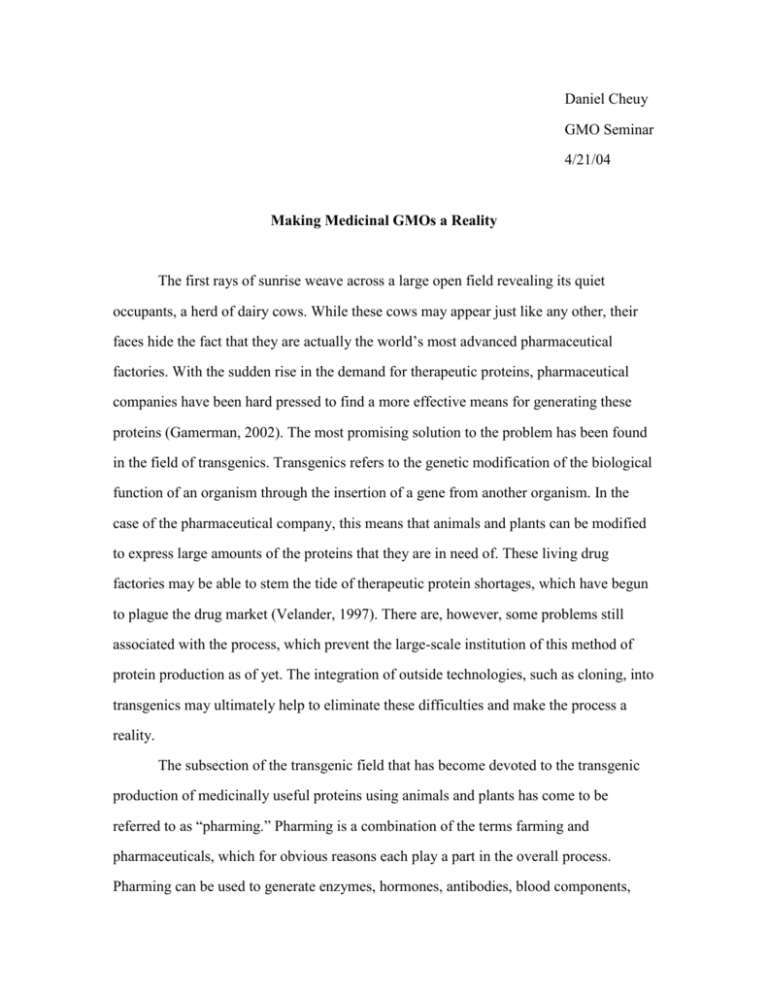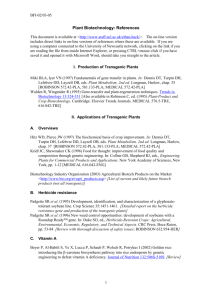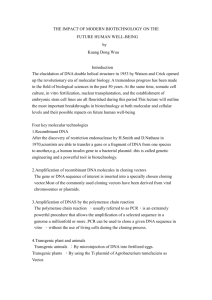Making Medicinal GMO`s a Reality
advertisement

Daniel Cheuy GMO Seminar 4/21/04 Making Medicinal GMOs a Reality The first rays of sunrise weave across a large open field revealing its quiet occupants, a herd of dairy cows. While these cows may appear just like any other, their faces hide the fact that they are actually the world’s most advanced pharmaceutical factories. With the sudden rise in the demand for therapeutic proteins, pharmaceutical companies have been hard pressed to find a more effective means for generating these proteins (Gamerman, 2002). The most promising solution to the problem has been found in the field of transgenics. Transgenics refers to the genetic modification of the biological function of an organism through the insertion of a gene from another organism. In the case of the pharmaceutical company, this means that animals and plants can be modified to express large amounts of the proteins that they are in need of. These living drug factories may be able to stem the tide of therapeutic protein shortages, which have begun to plague the drug market (Velander, 1997). There are, however, some problems still associated with the process, which prevent the large-scale institution of this method of protein production as of yet. The integration of outside technologies, such as cloning, into transgenics may ultimately help to eliminate these difficulties and make the process a reality. The subsection of the transgenic field that has become devoted to the transgenic production of medicinally useful proteins using animals and plants has come to be referred to as “pharming.” Pharming is a combination of the terms farming and pharmaceuticals, which for obvious reasons each play a part in the overall process. Pharming can be used to generate enzymes, hormones, antibodies, blood components, and vaccines in living plant and animal drug factories (Gillespie, 2003). For example, a transgenic cow, which possesses a transgene encoding for a viral surface antigen, could be generated. The antigen could be expressed in and harvested from the milk. The purified antigen could then be used as the active ingredient in the vaccine for the virus. Transgenic technology itself consists of generating an animal or plant that contains a foreign gene, a transgene, through modification of its genome. The gene that is selected for insertion typically encodes a protein product with therapeutic or medicinal value. In order to generate a true transgenic organism, the transgene must be incorporated into every single cell of the animal. The technique for transgene insertion is referred to as pronuclear microinjection because a fine glass syringe is used to pierce the cell membrane and inject the foreign DNA, which consists of a gene and a promoter, into the cell (Das, 2001). Injecting the gene into the trillions of cells in an adult organism would be impossible; therefore, researchers create transgenic animals by inserting the transgene into the single celled form of the animal (Gillespie, 2003). Every animal begins life as a single cell prior to division and development. Once the transgene has been successfully introduced into the single cell, subsequent division and development of that lone cell will ensure that the desired gene is present in every future cell generated. The transgene product’s expression is induced to occur within certain biological processes through the use of specific promoters, which ensure that the gene’s protein product is incorporated into either the animal’s milk, eggs, urine, or blood. Processes, such as milk production, are desirable for the expression of protein because they are well suited for collection purposes. A truly successful transgenic animal would produce large amounts of therapeutic protein, remain unaffected by any of the potential deleterious effects of the transgene insertion, and pass that gene on to its offspring (Gillespie, 2003). The gene insertion technique alone, however, is not enough to guarantee the transition to solely animal and plant transgenic methods of protein production. Other techniques from other fields of scientific research, such as cloning, must be incorporated into the transgenic field in order to ensure its usage in the future. While the technique of gene insertion is relatively easy, one of the major obstacles associated with the use of genetically modified animals is that it is difficult to rapidly establish a large herd of animals that all express the desired gene product and do so in relatively large quantities. The process of determining whether or not an animal is a good candidate is so labor intensive because scientists must determine whether or not each animal successfully expresses the protein, expresses it in the correct biological process, and whether or not it produces enough. One method for circumventing this obstacle is through the use of cloning technology (Rohricht, 1999). If scientists can create and identify the ideal protein producing animal, then they can clone that animal rather than waste precious time and resources on creating and identifying hundreds of other good herd candidates. Traditional breeding would be more time consuming because the transgenic animals would be mated with non-transgenic animals generating offspring that are heterozygous for the transgene. The heterozygous offspring would then be mated with one another in order to create offspring homozygous for the desired gene. These homozygous animals would then be used as the foundation for the protein producing population. The particular cloning technique that would be used to circumvent the traditional breeding process is somatic cell nuclear transfer. Somatic cell nuclear transfer involves using microsurgical instruments to remove the nucleus from a somatic cell of the animal to be cloned. This donor animal is typically selected because it demonstrates an above average level of protein production. The nucleus of this cell is then inserted into a cytoplast, which is an oocyte that has had its nucleus removed (Wells, 2003). The newly fertilized egg is then induced to begin division and development via electric shock. The fertilized egg is then implanted into the uterus of a surrogate mother and allowed to come to term (Hodges, 2003). By combining this cloning technique with transgenics, scientists will be capable of establishing large herds of protein-producing animals in a relatively short amount of time. It is only with the establishment of these sufficiently large populations that pharmaceutical companies will be able to make the transition from traditional methods of protein production to their animal factory alternatives. The incorporation of cloning and transgenic technologies is not enough to permit the implementation of living drug factories because cloning technology enjoys its share of problems. In order for cloning to have a significant impact on transgenics, its own obstacles must be overcome. The greatest difficulty with regard to cloning is that its techniques are not highly successful. For example, the success rate of somatic cell nuclear transfer is between 1 and 3% with regard to the full development of the clone organism (Hodges, 2003). Most cloned embryos are lost prior to birth due to improper development. Research devoted to resolving developmental problems in cloned organisms centers on nuclear reprogramming. Since the nucleus inserted into the enucleated oocyte belonged to a differentiated cell, it is essential that the nucleus change developmental fates so that it can once again access the genes necessary for proper development. The inability of the donor nucleus to reprogram properly is believed to be the source of all the problems associated with cloning. Researchers have found that exposing the donor nucleus to remodeling factors prior to transfer eases its reprogramming process. Factors, such as Xenopus laevis egg extract, roscovitine, and trichostatin A, appear to increase the efficiency of the cloning process through inhibition of transcription, cell cycle synchronization and enhancement of development rate (Hodges, 2003). For example, the inhibition of transcription facilitates nuclear reprogramming because it forces the nucleus to halt the characteristic form of gene expression it acquired during cell differentiation so that the cell can then reactivate the genes essential to the developmental process. These recent advances in nuclear reprogramming efficiency bode well for the future applications of cloning in the transgenic field. Some additional risks, which are associated with the usage of transgenics, still must be addressed. The genetic alteration of animals may have unseen effects, especially with regard to nuclear transfer. While abnormalities that affect development, are more easily visible, there may be additional abnormalities that exist in the cloned animals that may not be discovered until after the animal or plant has entered into protein production (Tong, 2002). Until scientists can be completely sure of a clone’s health status, there is a potential for disastrous long-term consequences. For example, a clone with an unseen genetic defect affecting protein assembly is capable of producing harmful therapeutic proteins that could cause doctors to unknowingly prescribe medication that might actually exacerbate their patient’s condition. Another potential problem with the production of protein in transgenic animals and plants is the fact that there are protein modification disparities between the animal, who produces the protein, and the human, who ingests them. This is more specifically a problem associated with the consumption of a therapeutic protein directly from the plant or animal, which is a concern especially pertinent in third world countries. These differences in protein modification may be responsible for generating a whole host of new allergic reactions in response to these therapeutic proteins. Yet another possible problem with the usage of cloning is the loss of biodiversity. Cloned herds are more susceptible to disease because of their lack of genetic variability. Essentially, what wipes out one animal will wipe out all the animals. If herds of cloned, transgenic animals are responsible for supplying the world’s therapeutic proteins, then a single disease could effectively decimate the clone population and the world’s protein supply in one fell swoop. While other transgenic embryos will most likely be maintained, it will still take time to establish equivalently large and productive herds should a disaster occur. Biodiversity helps to ensure that there will always be individuals in a population that will survive and without this genetic variability a population is put in a very precarious position (Chye, 2001). Another possible risk associated with the use of transgenic animals and plants for protein production is the fact that the proteins they produce could introduce newly evolved prions into the human population. For example, mad cow disease was passed on to humans because of their consumption of the diseased animal’s meat. The protein’s produced by a diseased transgenic animal could have the same effect. The therapeutic protein could simply serve as a vehicle for prions from one species to another. Prions are more dangerous than viruses because they can lie dormant. A prion is a protein susceptible to improper folding that can become highly infectious and often fatal (Larrick, 2001). That means that humans may not realize the transfer of newly evolved prions into the population via therapeutic proteins until it is too late. It is important to analyze the traditional large-scale methods of protein production in order to gain a better appreciation of the benefits of the pharming method. The traditional methods involve either bacterial culture or cell fermentation. First, the cells must be transformed with a plasmid so that the desired gene can be incorporated into the cells for expression and production. Those cells that are not transformed must be discarded, which can result in large initial losses. In order to maximize the efficiency of the fermentation process pH, oxygen concentration, and temperature must be closely monitored (Christensen, 2004). Once the protein has been produced, it must be harvested. Protein harvesting can prove to be difficult in fermentation because the timetable for harvesting varies from protein to protein. There is also the potential for the loss of the plasmid at any point during the fermentation process, which can often result in sudden diminished yields. Yield can also vary from culture to culture because of slight variations in culture mediums. Another potential problem with fermentation is the potential for contamination of the cell cultures. The longer the fermentation process runs the more difficult it is to maintain sterile conditions. In order to harvest the protein, the cells must first be separated from the culture medium through either filtration or centrifugation, which on such a large-scale can be labor intensive. The next step involves disrupting the cells so that the product can be removed. The disruption must be strong enough to disrupt the cell, but not so strong that it disrupts the protein as well. Some conventional disruption methods involve enzymes, osmotic shocks, freeze-thaw cycles, organic solvents, and detergents (Christensen, 2004). The traditional methods for the production of protein are limited by the resources required to construct a manufacturing facility, and by the facility’s manufacturing capacity. It is because of these limitations and difficulties that traditional methods for the production of protein can no longer supply the increasing demand for therapeutic proteins. The greatest advantage of pharming over fermentation is the fact that animals and plants are renewable resources that can continually produce large amounts of protein without the need for tedious monitoring and harvesting techniques. Fermentation, on the other hand, requires that the carefully cultured cells be disrupted and discarded with each protein harvest. Transgenic animals and plants are conditioned to incorporate the production of the therapeutic protein into a normally occurring biological process, such as milk production, so that the protein can be easily collected and isolated without the need for the destruction of the living bioreactor. The pharming method is also much more cost effective because of the continual need for the reinvestment of capital in the expenses associated with the traditional cell culture process. For example, the average cost of a cell culture facility is a whopping 250 million dollars (Gamerman 2002). A transgenic cattle facility, on the other hand, would cost only slightly more than an average cattle farm. With the increasing number of therapeutic proteins entering the market everyday, the establishment of transgenic cattle facilities would cost considerably less than the establishment of their cell culture facility counterparts. With the integration of cloning into the process of transgenics, the establishment of a large-scale transgenic cattle facility would require even less time, making the facility an even more attractive option. This means that therapeutic protein product could be derived from the transgenic animals in the facility from as early as twelve months, while the construction of a cell culture facility would require at least two years (Gamerman 2002). Maintenance expenses are also much less for a transgenic animal facility. Animal feed, such as hay and grain, is much less expensive than comparable amounts of carefully prepared cell culture media. Animal and plant pharming requires a much lower investment of capital when compared with traditional cell culture techniques for the production of therapeutic protein (Larrick, 2001). As a result, the transgenic animal and plant method of protein production is much more cost effective and efficient than the traditional methods of bacterial culture and fermentation. While the integration of outside technology, such as cloning, into the transgenic field might increase their efficiency and practicality, perhaps the greatest obstacle to be overcome lies in the realm of social acceptance. When all of the scientific difficulties associated with pharming have been addressed, there is still the question of whether or not the global population will accept the usage of the technology. If there is no public support, then the availability of the technology will become irrelevant. However, this begs the question of whether or not the public will actually have a choice since current methods of protein production are incapable of supporting the ever-increasing demand. For this reason, the lines of communication between the scientific community and the public must remain open. In order for pharming to become a reality, transgenic technology must become infused with techniques developed in other areas of scientific research, such as cloning. The integration of these technologies will allow for the elimination of many of the logistic obstacles associated with the institution of this method of protein production (Zinnen, 1999). Traditional cell culture methods for the large-scale production of therapeutic protein have reached capacity and become unable to supply the demand. Pharming techniques, however, have advanced rather quickly due to the incorporation of technologies, such as cloning, and are now poised to replace the traditional production method. Once the pharming technique has been fine-tuned and the potential risks fully addressed, pharmaceutical companies will be capable of instituting the process in order to more efficiently supply the increasing demand for medicinally useful proteins. References Christensen, Alan H. “Large Scale Production of Proteins From Recombinant Microorganisms” GMU Biology 2004. 14 April 2004 <http://www.gmu.edu/departments/biology/385-Ch16-LargeScalePrdtn/sld001.htm>. Chye, Ng S. “Somatic Cell Nuclear Transfer.” Bio-Ethics Advisory Committee 2001. 19 March 2004. <http://www.bioethics-singapore.org/resources/pdf/Annex%20%E%20%20SOMATIC%20CELL%20NUCLEAR%20TRANSFER.pdf>. Das, Rathin C. (2001). Production of therapeutic proteins from transgenic animals. BioBusiness 20, 60-64. Gamerman, Gary. “Producing Therapeutics in Transgenic Animals.” BioPortfolio 2002.4 April 2004. < http://www.bioportfolio.com/news/btech_032702_2.html>. Gillespie, David. “Pharming for Pharmaceuticals.” University of Utah Genetics 2003. 8 March 2004 <http://gslc.genetics.utah.edu/features/pharming>. Hodges, Craig A., and Stice, Steven L. (2003) Generation of bovine transgenics using somatic cell nuclear transfer. Reprod Biol Endocrinol 1, 81-85. Larrick, James W. and David W. Thomas (2001). Producing proteins in transgenic plants and animals. Curr Opin Biotechnol 12(4), 411-8. Rohricht, Paul and David Ayares (1999) Transgenic Protein Production Part 3, Nuclear Transfer Technology. BioPharm 12, 56-59. Tong, W.F., Ng W.F., and Ng S.C. (2002). Somatic Cell Nuclear Transfer (Cloning): Implications for the Medical Practitioner. Singapore Med J 43, 369-376. Velander, W.H., Lubon H., and Drohan W.M. (1997). Transgenic Livestock as Drug Factories. Scientific American 276, 70-75. Wells, David. “Cloning and Transgenic Technology to Produce Genetically Enhanced Dairy Cattle in the Future.” Reproductive Technologies Group 2003. 27 March 2004. <http://www.dexcel.co.nz/pdf_files/fd99/fd99wells.pdf>. Zinnen, Thomas M. “Cloning and Transgenic Animals: The Influence of Technial Confluence.” The National Health Museum 1999. 27 March 2004. <http://www.accessexcellence.org/AB/BA/casestudy4.html>.








